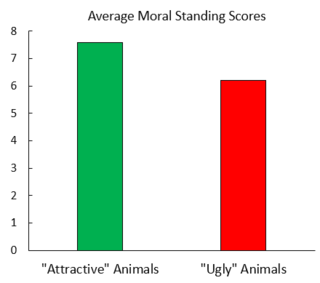Beauty
Why People Care More About Beautiful Animals Than Ugly Ones
New studies show how beauty affects the moral standing of other species.
Posted January 28, 2022 Reviewed by Tyler Woods
Key points
- The “beauty bias” is the tendency to unconsciously attribute more socially desirable traits to attractive people.
- A new standardized animal image database allows researchers to study how beauty and ugliness affect our attitudes towards other species.
- Whether people care about animals is more related to how cute they are than the species’ capacity to think and feel or their harmfulness.
- Is the human tendency to elevate the moral standing of attractive animals an example of "beauty speciesism?"

Each week, The New York Times Sunday Magazine includes a Dear Abby-style advice column called “The Ethicist” where people can run their moral quandaries by a philosopher-in-residence. Judy Barrett of Greensboro, North Carolina once submitted a letter to the ethicist lamenting her conflict over the treatment of birds. She and her husband were crazy about bluebirds. They had spent a lot of money and effort to entice a pair of them to nest in their backyard: they installed a snake-proof bluebird nest box and a special birdbath, and they even bought packages of mealworm bluebird treats. To their dismay, however, a common sparrow hijacked the nest box and laid five eggs in the bluebird house. Judy turned to The Ethicist for advice. She wrote, “When is it permissible to destroy a nest of undesirable feathered folk? We want bluebirds, not common yard sparrows.”
Randy Cohen, the NYT ethicist at the time, was having none of it. “In ethics,” he wrote, “cuteness doesn’t count.”
When Does Cuteness Count?
When it comes to how humans really think about animals, is it true that cuteness does not count? Several recent studies have taken this question on. The first was by a research team led by Catarina Possidónio of the Iscte - University Institute of Lisbon and was published in the journal Animals. They developed a publically available bank of standardized photographs investigators can use to study attitudes toward animals, the Animal Images Database. Each of the 120 images in the database consists of a color photograph of a single animal on a white background with its head positioned to the right. The photographs include species ranging from leaches and earthworms to cows and chimpanzees.
The researchers asked 509 Portuguese adults to rate the animals on eleven dimensions using a 1 to 7 scale. These included the perceived dangerousness of the animal, its capacity to think and feel, its acceptability for humans to eat the animal, the degree subjects felt care and protection for it, and its cuteness.
The researchers found that differences in the moral concern and protectiveness for a species were more related to how cute it was than any other factor, including their capacity to think and feel (for stat nerds, r = .75). This graph shows the cuteness scores and the concern/protection scores for the 35 photographs of mammals. As you can see, people thought cute animals, like dolphins and koalas, deserved more moral consideration than less attractive species, like bats and boars.

“Cute” Animals Versus “Beautiful” Animals
Why do humans care more about cute animals than ugly ones? One explanation is that cute animals remind us of human babies. Indeed, several studies have reported that animals with characteristics like big eyes and soft facial features trigger our parental care instincts. While it is probably true that all “cute” animals are beautiful, it is not true that all beautiful animals are cute. For example, male peacocks, San Francisco garter snakes, and monarch butterflies are strikingly beautiful, yet they don’t elicit what the anthrozoologist James Serpell calls the human cute response.
Recently, researchers from the University of Melbourne led by Christoph Klebl explored another factor that affects our preferences for some species over others—pure physical attractiveness. They knew that attractive people are more likely to be perceived as intelligent and competent than unattractive individuals. This phenomenon is called attractiveness bias or the “Beauty-Is-Good Stereotype.” In a pair of studies published in the Journal of Environmental Psychology, Klebl and his colleagues used the photos in the Animal Images Database to see if this bias toward attractive people also applies to other species.
Their first study was aimed at determining whether perceived beauty influenced a creature's moral standing independent of the species’ cognitive capacities and their harmfulness to humans. For example, people might give elevated moral status to attractive animals, not because of their beauty, per se, but because they are perceived as more intelligent or capable of experiencing happiness. And we might tend to care less about harming ugly animals because they are viewed as dangerous, not because they are ugly.
The subjects in the study were 540 American adults recruited through MTurk, Amazon’s online subject pool. Each participant rated ten of the 120 photos in the Animal Images Database on a series of 23 attributes using a zero (not at all) to ten (very much so) scale. The items fell into three categories: Cognition (the researchers called this “patency/agency”), Harmfulness, and Beauty. Finally, the subjects rated the animals on a three-item Moral Standing Scale.
The researchers found that moral concern for a species was highly related to both its beauty and our views of its cognitive capacities. Surprisingly, a species’ moral standing was only weakly related to its potential harmfulness. Further analysis indicated that the beauty or ugliness of a species—in and of itself—predicted its moral status independently of its cognitive capacities or harmfulness. In short, we tend to be more concerned about beautiful animals than ugly animals despite their ability to suffer or experience pleasure or whether or not they could cause us harm.
Does Beauty Cause Increased Moral Concern?
These results, however, were based on statistical relationships—correlations—rather than an experiment. And, as Stat 101 instructors drum into their students’ heads, just because two things are correlated, does not mean that one is causing the other—for example, the positive correlation between ice cream sales and shark attacks (both of which are more likely caused by it being summer than related to each other).
Hence, the Australian researchers conducted a second study to strengthen their claim that beauty causes an increase in the moral standing of an animal. Their quasi-experiment was clever. They selected seven pairs of images of different species from the Animal Images Database. One member of each pair had been rated in their first study as being particularly beautiful and the other as ugly. They chose the pairs carefully so that the beautiful and the ugly members of the pairs did not differ in their cognition or harmfulness scores. The pairs are shown below. The animals on the top row were in the “beautiful condition,” and the animals on the bottom row were in the “ugly condition.” The research hypothesis was that the seven beautiful animals would, on average, score higher on the moral standing scale than animals in the “ugly” condition.

The subjects were 377 adults living in the U.K. recruited through Prolific, an online source of research participants. Half of the subjects evaluated photos of the seven “beautiful” animals in the pairs and half rated the seven “ugly” animals. The animals were rated on their beauty and also on their moral standing. The moral standing scale consisted of five items such as, “How morally wrong would it be to kill this animal?”
Bingo…the results confirmed their hypothesis. As shown in this graph, the moral standing scores of the seven beautiful animals were higher than the scores of the seven “ugly” animals, even though the two groups were the same in their perceived intelligence or ability to feel pain and the degree they were harmful to humans.

These studies raise a host of interesting questions.
How do categories affect the attractiveness of animals? For example, do we find cats cuter than foxes because they are considered pets?
How does culture affect the attractiveness of a species? Are cows viewed as more attractive in India, where they are sacred?
Can manipulations of images of ugly but endangered species make people more likely to donate money to save them from extinction?
Together, these studies suggest that Randy Cohen, the New York Times ethicist, is wrong. In the real world of animals and ethics, cuteness—and beauty—does count. And they raise an important ethical question: Is the human tendency to elevate the moral standing of attractive animals an example of "beauty speciesism."
References
Possidónio, C., Graça, J., Piazza, J., & Prada, M. (2019). Animal images database: Validation of 120 images for human-animal studies. Animals, 9(8), 475.
Klebl, C., Luo, Y., Tan, N. P. J., Ern, J. T. P., & Bastian, B. (2021). Beauty of the Beast: Beauty as an important dimension in the moral standing of animals. Journal of Environmental Psychology, 75, 101624.
Serpell, J. (2003). Anthropomorphism and anthropomorphic selection—beyond the" cute response". Society & Animals, 11(1), 83-100.




